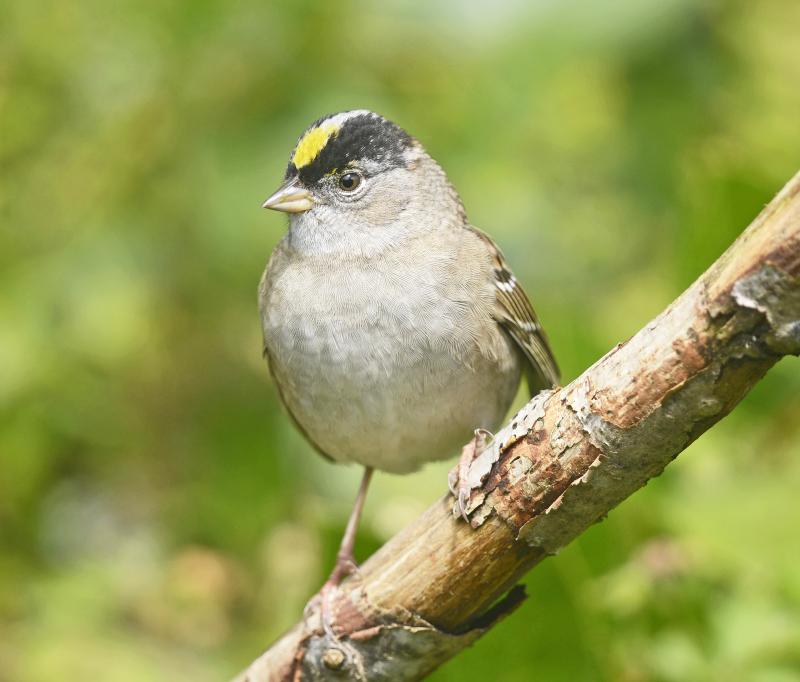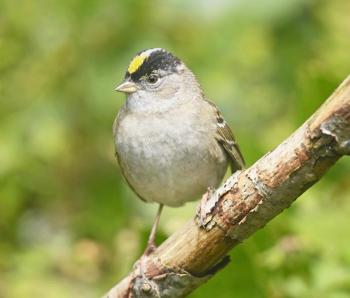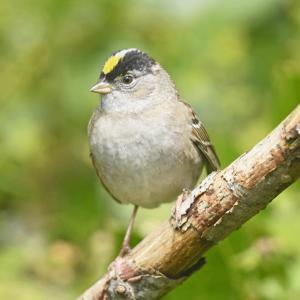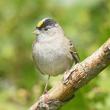The Bird That Could be King
By the time you read this, Election Day proper will have come and gone, and who knows what you will be experiencing? Whatever it is, we hope that this column will be a welcome diversion.
Thirty-five years ago, when Ronald Reagan was president and Joe Brennan was governor, we boarded a ferry on the Portland waterfront one brutally cold January morning. The ferry brought us and some other birders (we remember famed New Hampshire birder Denny Abbot among them) to Cliff Island, the outermost island in Casco Bay. Here we found our way to the home of some very nice folks who let us watch their feeders from the warmth of their cozy kitchen. Our hosts had discovered a very unusual bird coming to their feeders, a golden-crowned sparrow. In fact, this was the first golden-crowned sparrow ever documented in Maine!
Golden-crowned sparrows are birds of the West Coast of North America. Similar in size and shape to their close relatives, our familiar white-crowned and white-throated sparrows, they sport a golden-yellow crown bordered by jet black stripes. They nest in remote regions of Alaska, British Columbia, and Yukon. Back in the days of the Gold Rush when prospectors found themselves lonely and exhausted in the wilds of places like the Yukon, they described the melancholy whistled song of the bird as saying to them “no gold here.”
Golden-crowned sparrows go south to spend the winter right along the Pacific Coast from northern Baja Mexico north through California, Oregon, and Washington. In mid-winter in this region they can be quite common in brushy habitats. Since our first sighting of one in Maine all those years ago, we have been fortunate to have seen them many times in California and Washington during winter visits there.
But sometimes, a few still show up where they’re “not supposed to.” Golden-crowned sparrows have been found very occasionally across the eastern U.S. and Canada. A glance at eBird records shows perhaps a couple of dozen records east of the Mississippi in the past 10 years. Here in Maine there had been three well-documented and photographed birds and two unconfirmed sightings up until a few weeks ago. That’s when one was found coming to a feeder in Abbot, just south of Greenville. The bird stayed for four days, delighting many birders who made the trek to see it.
Oddly enough, another identifiably different golden-crowned sparrow was found a week and half later in Rimouski, Quebec, about 200 miles north of Abbot on the south shore of the St. Lawrence. Amazingly these are the only two records of the species reported to eBird in the entire eastern half of the continent this fall!
Our trip out to Cliff Island on Casco Bay in January of 1985 did result in our easily seeing our first and Maine’s first golden-crowned sparrow. That bird in fact spent the rest of the winter at our gracious hosts’ feeders, last being seen there in late April of 1985. As we rode back on the cold ferry across Casco Bay later that day, we felt warm remembering the golden crowned glory of the king of sparrows.
Jeffrey V. Wells, Ph.D., is a Fellow of the Cornell Lab of Ornithology and Vice President of Boreal Conservation for National Audubon. Dr. Wells is one of the nation's leading bird experts and conservation biologists and author of the “Birder’s Conservation Handbook.” His grandfather, the late John Chase, was a columnist for the Boothbay Register for many years. Allison Childs Wells, formerly of the Cornell Lab of Ornithology, is a senior director at the Natural Resources Council of Maine, a nonprofit membership organization working statewide to protect the nature of Maine. Both are widely published natural history writers and are the authors of the popular book, “Maine’s Favorite Birds” (Tilbury House) and “Birds of Aruba, Bonaire, and Curaçao: A Site and Field Guide,” (Cornell University Press).
Event Date
Address
United States

























